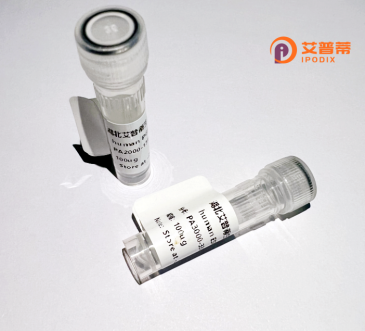
| 纯度 | >90%SDS-PAGE. |
| 种属 | Human |
| 靶点 | NCOA5 |
| Uniprot No | Q9HCD5 |
| 内毒素 | < 0.01EU/μg |
| 表达宿主 | E.coli |
| 表达区间 | 1-579 aa |
| 活性数据 | MNTAPSRPSP TRRDPYGFGD SRDSRRDRSP IRGSPRREPR DGRNGRDARD SRDIRDPRDL RDHRHSRDLR DHRDSRSVRD VRDVRDLRDF RDLRDSRDFR DQRDPMYDRY RDMRDSRDPM YRREGSYDRY LRMDDYCRRK DDSYFDRYRD SFDGRGPPGP ESQSRAKERL KREERRREEL YRQYFEEIQR RFDAERPVDC SVIVVNKQTK DYAESVGRKV RDLGMVVDLI FLNTEVSLSQ ALEDVSRGGS PFAIVITQQH QIHRSCTVNI MFGTPQEHRN MPQADAMVLV ARNYERYKNE CREKEREEIA RQAAKMADEA ILQERERGGP EEGVRGGHPP AIQSLINLLA DNRYLTAEET DKIINYLRER KERLMRSSTD SLPGPISRQP LGATSGASLK TQPSSQPLQS GQVLPSATPT PSAPPTSQQE LQAKILSLFN SGTVTANSSS ASPSVAAGNT PNQNFSTAAN SQPQQRSQAS GNQPPSILGQ GGSAQNMGPR PGAPSQGLFG QPSSRLAPAS NMTSQRPVSS TGINFDNPSV QKALDTLIQS GPALSHLVSQ TTAQMGQPQA PMGSYQRHY |
| 分子量 | 65.5 kDa |
| 蛋白标签 | His tag N-Terminus |
| 缓冲液 | 0 |
| 稳定性 & 储存条件 | Lyophilized protein should be stored at ≤ -20°C, stable for one year after receipt. Reconstituted protein solution can be stored at 2-8°C for 2-7 days. Aliquots of reconstituted samples are stable at ≤ -20°C for 3 months. |
| 复溶 | Always centrifuge tubes before opening.Do not mix by vortex or pipetting. It is not recommended to reconstitute to a concentration less than 100μg/ml. Dissolve the lyophilized protein in distilled water. Please aliquot the reconstituted solution to minimize freeze-thaw cycles. |
以下是关于NCOA5蛋白的3篇代表性文献示例(信息基于公开研究整理):
1. **文献名称**:NCOA5 Haploinsufficiency Results in Hepatic Steatosis and Hepatocellular Carcinoma in Mice
**作者**:Hua, X. et al.
**摘要**:该研究发现小鼠中NCOA5杂合缺失会引发肝脏脂肪变性及肝癌,揭示NCOA5通过调节脂代谢基因和炎症通路抑制肝细胞癌的发生,提出其在代谢相关肝癌中的抑癌作用。
2. **文献名称**:NCOA5 modulates estrogen receptor α signaling in glucose homeostasis
**作者**:Xiong, S., Wang, Q.
**摘要**:研究显示NCOA5作为雌激素受体α(ERα)的共激活因子,通过介导ERα与胰岛素信号通路的互作影响胰岛β细胞功能,NCOA5缺陷导致小鼠出现性别二态性葡萄糖代谢紊乱。
3. **文献名称**:NCOA5 links metabolic syndrome-associated inflammation to cell cycle progression
**作者**:Zhang, Y. et al.
**摘要**:文章阐明NCOA5通过协调细胞周期蛋白(Cyclin D1)和NF-κB通路的平衡,调控代谢综合征中的炎症反应与细胞异常增殖,提示其在代谢-癌症轴中的桥梁作用。
注:以上文献为领域相关研究方向示例,实际引用时建议通过PubMed或Web of Science检索具体论文确认详细信息。
**Background of the Nuclear Receptor Coactivator 5 (NCOA5) Protein**
NCOA5. also known as Nuclear Receptor Coactivator 5. is a transcriptional coactivator involved in regulating gene expression by interacting with nuclear receptors and other transcription factors. It contains a conserved LXXLL motif, enabling its binding to ligand-activated nuclear receptors such as estrogen receptor alpha (ERα) and peroxisome proliferator-activated receptors (PPARs), thereby modulating metabolic and inflammatory pathways. NCOA5 plays dual roles in cellular processes, acting as both a coactivator and a corepressor depending on physiological context.
Functionally, NCOA5 is critical in maintaining metabolic homeostasis, particularly in glucose and lipid metabolism, and has been implicated in hepatic insulin sensitivity. Studies link NCOA5 dysregulation to metabolic disorders, including type 2 diabetes, and cancers such as hepatocellular carcinoma (HCC), where its reduced expression correlates with tumor progression. Additionally, NCOA5 exhibits sexual dimorphism in liver gene expression, potentially contributing to sex-biased disease susceptibility.
NCOA5 also interacts with chromatin modifiers and signaling pathways (e.g., NF-κB), influencing inflammation and oxidative stress responses. Its role in DNA damage repair further underscores its tumor-suppressive properties. Recent research highlights its potential as a therapeutic target, though mechanistic insights remain incomplete. Recombinant NCOA5 proteins are utilized to study these pathways, advancing understanding of its molecular interactions and disease associations.
×